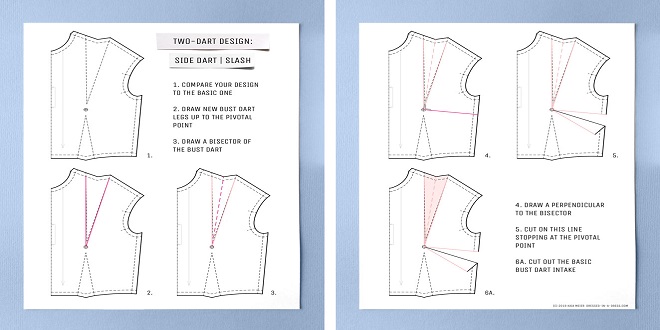Introduction
The dart is one of the most flexible and creative parts of the pattern. The space (excess) between the dart legs can be used in a variety of creative ways, limited only by the imagination of the designer. Dart excess used as design is referred to as dart equivalent. Dart equivalents are illustrated as tuck-darts, pleats, flares, and gathers. Dart equivalents replace the dart as control and will always be directed to the pivotal point of a pattern (such as bust point).
Gathers
Gathers are illustrated using the slash-spread and pivotal-transfer techniques. Gathers change the look of the basic garment but do not affect the fit. The slash-spread technique illustrates half of the dart excess used for gathers, and the pivotal-transfer technique illustrates all of the dart excess transferred for gathers
Dart clusters and dart equivalents
The dart excess may be divided among multiple openings and treated as a single design unit. When used as a single design unit, the dart excess may be identified as a group of basic or stylized darts, tuck-darts, pleats, or a variation in any combination desired.
Graduated and radiating darts
Graduated darts are darts of varying length within a group. Radiating darts spread out (radiate) from a focal point in a balanced arrangement and may be of the same or a graduated length. To prevent bulging at the tip of the darts that are farthest from the bust mound, the dart intake is generally 1/2 inch, with all remaining excess being absorbed by the dart closest to the bust mound. Use back pattern to complete the design
Parallel darts
Parallel darts can be created by using the dart points, or the bust point and dart point of a two-darted pattern. Space between the parallel darts can be increased by moving the dart point of the side dart farther from bust point.
Asymmetric darts
Asymmetric darts cross center front of the garment. Pattern shapes will change radically from that of the working pattern. Asymmetric darts require special pattern handling and identification, as do all designs that differ from side to side. Compare pattern shapes with each design. Cut basic back to complete the design for test fit.
- A full front pattern is required.
- Right-side-up instructions are necessary.
- The existing dart of the working pattern may interfere with the placement of a stylized dart. If so, the dart should be transferred temporarily to another location (such as mid-armhole) before the pattern is plotted. Seam allowance is illustrated for each pattern because of the dart’s unique shape and location.
Intersecting darts
Intersecting darts resemble asymmetric darts and dart equivalents. The darts cross center front and intersect with each other. To complete the design, use basic back pattern.
Summary
Use your measurements (shown by asterisks) for the draft of the basic sleeve. Read the instructions. Use the cap height from the sleeve measurement chart, or use the formula to determine cap height.
 Thefashion2day Popular Fashion News Website
Thefashion2day Popular Fashion News Website




